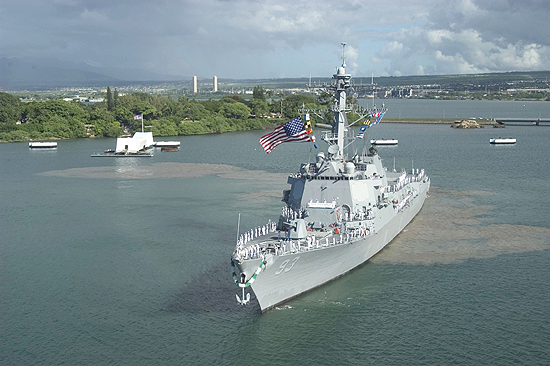Bulbous Bows
by Andrew Boyd
Today, bulbous bows. The University of Houston's College of Engineering presents this series about the machines that make our civilization run, and the people whose ingenuity created them.
Imagine a boat. Now picture its hull. Powerboats are squarish in back. But the bow is designed like a knife, moving water around and under the boat.

We don't find this design on most ships. Fully laden ships look as we might expect, bows slicing through the water.

But hidden beneath the surface is a large protrusion jutting forward like a giant clown's nose. You can see these outthrusts in quiet water, or when a ship is riding high above its waterline.

The bulbous bow traces its modern roots to David Taylor, Chief Constructor for the Navy during the First World War. Taylor noticed something about ships fitted with ram bows. Ram bows are designed to do just what the name suggests — ram other ships. Taylor observed that ships with ram bows weren't nearly as sluggish as designers predicted.
Further study led to the launching of the bulbous bowed battleship Delaware in 1909. But it took another two decades before the bulbous bow really made a splash. It came with the launch of the German passenger liner Bremen. The Bremen was the most technically sophisticated, and fastest, ship of her day. Designers took notice.
Six years later, the French liner Normandie, also with a bulbous bow, managed to reach an astonishing cruising speed of over thirty knots. Her rival, the British Queen Mary, achieved this same feat without a bulbous bow, but it had a much larger engine.
Still, bulbous bows wouldn't be fully embraced for many more decades. After all, how could an odd appendage help a ship move faster with less fuel? Naval architects had to rely on informed opinion since mathematical descriptions weren't fully developed at the time.
Even as the mathematics matured, it still had to be validated. Before computers that meant experimentation — building and testing physical models large and small. The arrival of computers opened the door for computational testing. Today, virtually every large oceangoing ship is designed with a bulbous bow, leading to fuel savings of about fifteen percent.

When a ship with a bulbous bow is moving forward, water flows over the bulb and creates a trough behind it. This trough reduces the wave generated by the edge of the bow. A smaller wave means less energy lost to the water.
Bulbous bows are designed to work optimally at a ship's normal cruising speed. At lower speeds they have little effect. They also don't do much for smaller vessels. Boats under about fifty feet won't realize any fuel savings.
The book isn't closed on bulbous bows. Ever new shapes are being designed and tested. Who knows what the future of maritime engineering holds'

I'm Andy Boyd at the University of Houston, where we're interested in the way inventive minds work.
Notes and references:
Bulbous Bow. From the Wikipedia Web site: https://en.wikipedia.org/wiki/Bulbous_bow. Accessed May 23, 2011.
Bulbous Bow. From the Web site: http://www.neely-chaulk.com/narciki/Bulbous_bow. Accessed May 23, 2011.
Wigley, W.C.S. 'The Theory of the Bulbous Bow and its Practical Application. Trans. NECIES, Vol. 52, 1936.
The picture of the powerboat is from the Bayliner Website. All other pictures are from Wikimedia Commons, Flickr, or U.S. government Websites.
Many thanks to Thomas Graf for his comments on this essay.